Financial Accounting Principles Report: Stakeholders and Statements
VerifiedAdded on 2020/12/24
|24
|6171
|483
Report
AI Summary
This report provides a comprehensive overview of financial accounting principles, focusing on UK GAAP and its application. It begins with an introduction to financial accounting, outlining its purposes and the importance of financial reporting. The report then explores internal and external stakeholders and their interests. Key elements such as journal entries, ledgers, and trial balances are examined through case studies. Further sections delve into profit and loss accounts, balance sheets, and accounting concepts like consistency and prudence. Depreciation methods, including straight-line and written-down value, are explained, followed by a comparison of financial statements prepared by sole traders and limited companies. The report also covers bank reconciliation statements, control accounts, and suspense accounts. Detailed examples and calculations, including journal entries and balance sheets, are provided throughout, making it a valuable resource for students studying financial accounting.
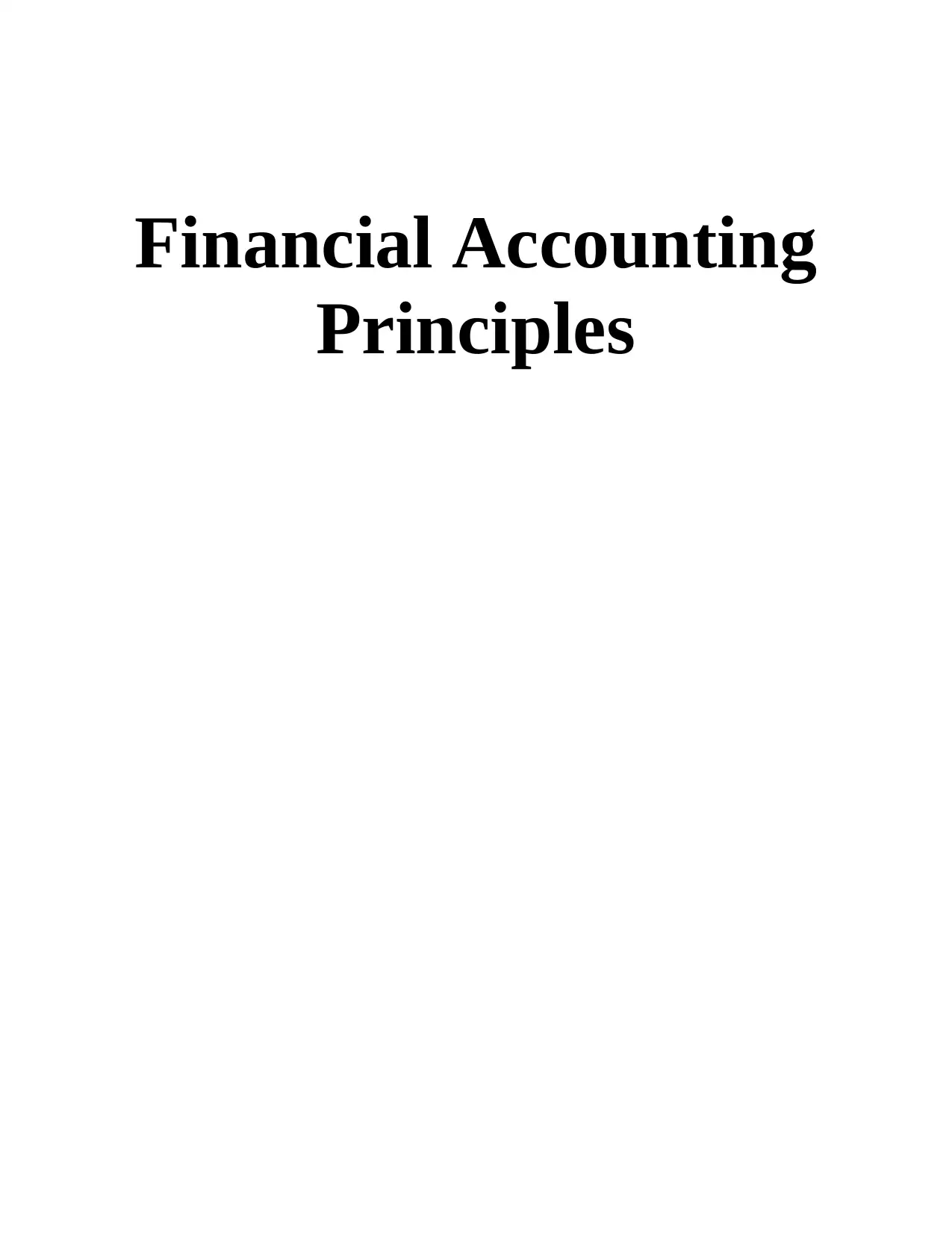
Financial Accounting
Principles
Principles
Paraphrase This Document
Need a fresh take? Get an instant paraphrase of this document with our AI Paraphraser
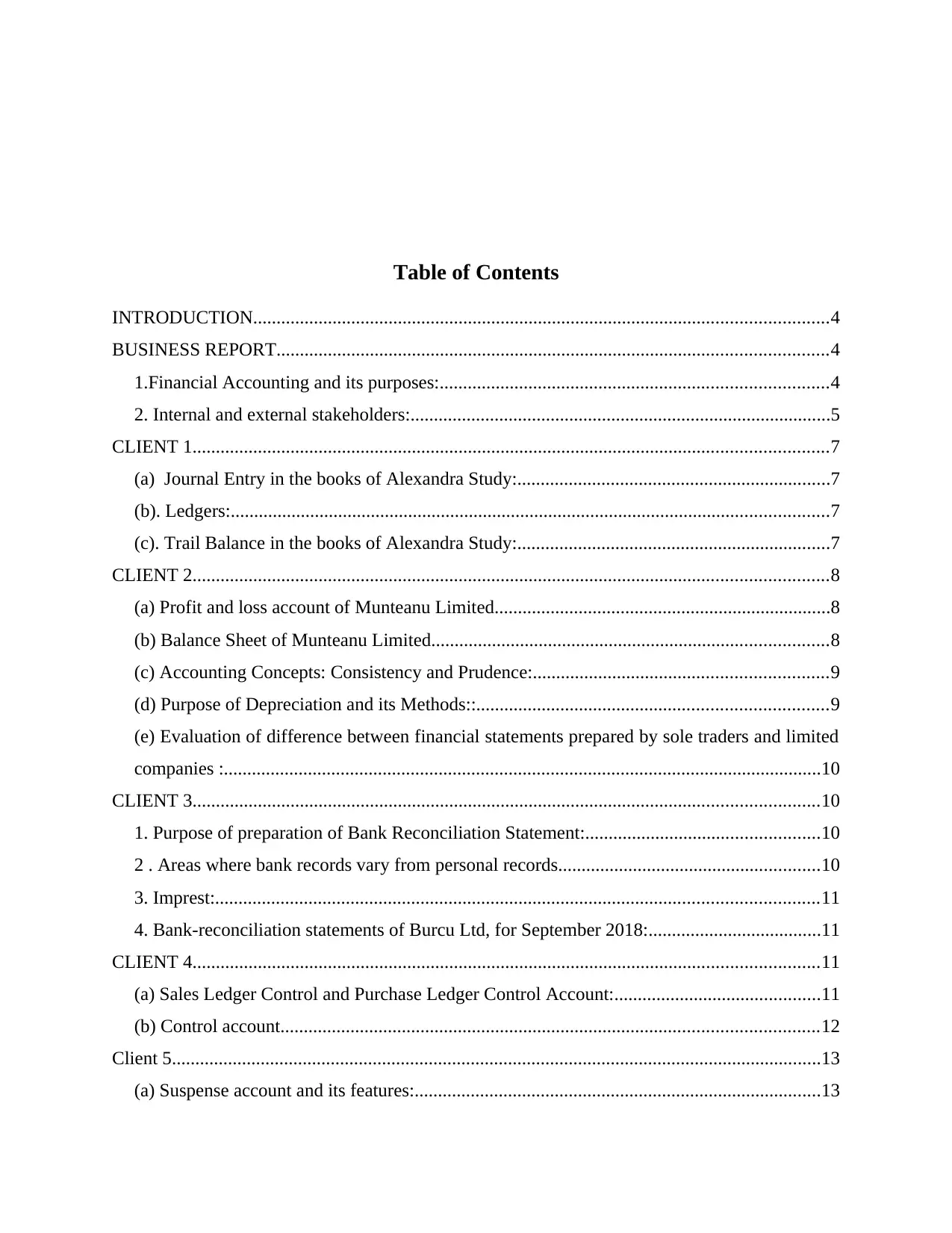
Table of Contents
INTRODUCTION...........................................................................................................................4
BUSINESS REPORT......................................................................................................................4
1.Financial Accounting and its purposes:...................................................................................4
2. Internal and external stakeholders:..........................................................................................5
CLIENT 1........................................................................................................................................7
(a) Journal Entry in the books of Alexandra Study:...................................................................7
(b). Ledgers:................................................................................................................................7
(c). Trail Balance in the books of Alexandra Study:...................................................................7
CLIENT 2........................................................................................................................................8
(a) Profit and loss account of Munteanu Limited........................................................................8
(b) Balance Sheet of Munteanu Limited.....................................................................................8
(c) Accounting Concepts: Consistency and Prudence:...............................................................9
(d) Purpose of Depreciation and its Methods::...........................................................................9
(e) Evaluation of difference between financial statements prepared by sole traders and limited
companies :................................................................................................................................10
CLIENT 3......................................................................................................................................10
1. Purpose of preparation of Bank Reconciliation Statement:..................................................10
2 . Areas where bank records vary from personal records........................................................10
3. Imprest:.................................................................................................................................11
4. Bank-reconciliation statements of Burcu Ltd, for September 2018:.....................................11
CLIENT 4......................................................................................................................................11
(a) Sales Ledger Control and Purchase Ledger Control Account:............................................11
(b) Control account...................................................................................................................12
Client 5...........................................................................................................................................13
(a) Suspense account and its features:.......................................................................................13
INTRODUCTION...........................................................................................................................4
BUSINESS REPORT......................................................................................................................4
1.Financial Accounting and its purposes:...................................................................................4
2. Internal and external stakeholders:..........................................................................................5
CLIENT 1........................................................................................................................................7
(a) Journal Entry in the books of Alexandra Study:...................................................................7
(b). Ledgers:................................................................................................................................7
(c). Trail Balance in the books of Alexandra Study:...................................................................7
CLIENT 2........................................................................................................................................8
(a) Profit and loss account of Munteanu Limited........................................................................8
(b) Balance Sheet of Munteanu Limited.....................................................................................8
(c) Accounting Concepts: Consistency and Prudence:...............................................................9
(d) Purpose of Depreciation and its Methods::...........................................................................9
(e) Evaluation of difference between financial statements prepared by sole traders and limited
companies :................................................................................................................................10
CLIENT 3......................................................................................................................................10
1. Purpose of preparation of Bank Reconciliation Statement:..................................................10
2 . Areas where bank records vary from personal records........................................................10
3. Imprest:.................................................................................................................................11
4. Bank-reconciliation statements of Burcu Ltd, for September 2018:.....................................11
CLIENT 4......................................................................................................................................11
(a) Sales Ledger Control and Purchase Ledger Control Account:............................................11
(b) Control account...................................................................................................................12
Client 5...........................................................................................................................................13
(a) Suspense account and its features:.......................................................................................13
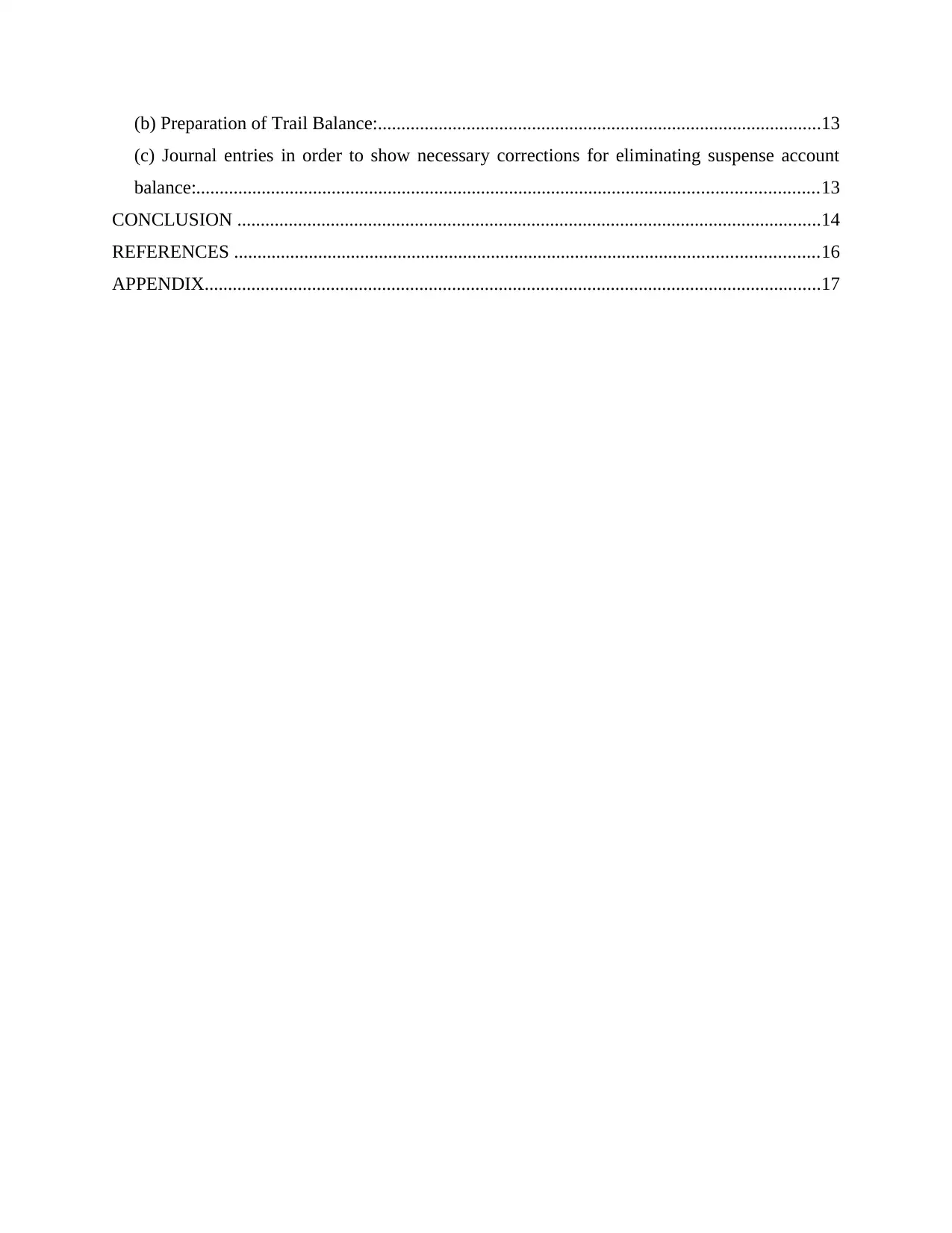
(b) Preparation of Trail Balance:...............................................................................................13
(c) Journal entries in order to show necessary corrections for eliminating suspense account
balance:.....................................................................................................................................13
CONCLUSION .............................................................................................................................14
REFERENCES .............................................................................................................................16
APPENDIX....................................................................................................................................17
(c) Journal entries in order to show necessary corrections for eliminating suspense account
balance:.....................................................................................................................................13
CONCLUSION .............................................................................................................................14
REFERENCES .............................................................................................................................16
APPENDIX....................................................................................................................................17
⊘ This is a preview!⊘
Do you want full access?
Subscribe today to unlock all pages.

Trusted by 1+ million students worldwide

INTRODUCTION
Financial accounting principles refers to various guidelines and rules which are necessary
for business organisation in order to report its financial data. Financial accounting process
includes recording of financial transactions, posing them in different ledgers, summarizing,
preparation of financial position statements and reporting of financial performance to various
stakeholders. These all activities involved in financial accounting process are governed by
financial accounting principles (Edwards, J. R., 2013). In UK common set of accounting
principles is UK GAAP(Generally Accepted Accounting Principles). Financial accounting
provides groundwork for decision making functions of business organisation. This report
exhibits financial accounting and its purposes, internal and external stakeholders, importance of
control accounts and main purpose of preparation of bank reconciliation statement.
BUSINESS REPORT
1.Financial Accounting and its purposes:
Financial accounting is unique field of accounting that includes a systematic process of
recording, classifying, summarizing and reporting of financial transaction resulting from various
functions of business organisation during a particular period. These financial transaction are
classified systematically in order to prepare final accounts such as balance sheet, profit and loss
account, profit and loss account or income statement, cash flow statements, change in equity
statement and other relevant statements, that are used by business organisations to assess actual
financial performance and position (Fourie, 2015). Reporting under financial reporting process
assist business organisations to present true picture about financial performance and position
before shareholders, government, employees, landers and creditors etc. In financial accounting
accounts are prepared by entities as per accounting principles, assumptions and different
guidelines, It is governed and administrated by intentional and local guidelines and standards.
Purpose of financial accounting: Following points are describing key purpose of financial
accounting, as follows:
Main purpose of financial accounting is reporting of actual position and performance to
internal and external users of financial data and information.
Activities in financial reporting is framed in a systematic way to provide smoothness in
accounting operations.
Financial accounting principles refers to various guidelines and rules which are necessary
for business organisation in order to report its financial data. Financial accounting process
includes recording of financial transactions, posing them in different ledgers, summarizing,
preparation of financial position statements and reporting of financial performance to various
stakeholders. These all activities involved in financial accounting process are governed by
financial accounting principles (Edwards, J. R., 2013). In UK common set of accounting
principles is UK GAAP(Generally Accepted Accounting Principles). Financial accounting
provides groundwork for decision making functions of business organisation. This report
exhibits financial accounting and its purposes, internal and external stakeholders, importance of
control accounts and main purpose of preparation of bank reconciliation statement.
BUSINESS REPORT
1.Financial Accounting and its purposes:
Financial accounting is unique field of accounting that includes a systematic process of
recording, classifying, summarizing and reporting of financial transaction resulting from various
functions of business organisation during a particular period. These financial transaction are
classified systematically in order to prepare final accounts such as balance sheet, profit and loss
account, profit and loss account or income statement, cash flow statements, change in equity
statement and other relevant statements, that are used by business organisations to assess actual
financial performance and position (Fourie, 2015). Reporting under financial reporting process
assist business organisations to present true picture about financial performance and position
before shareholders, government, employees, landers and creditors etc. In financial accounting
accounts are prepared by entities as per accounting principles, assumptions and different
guidelines, It is governed and administrated by intentional and local guidelines and standards.
Purpose of financial accounting: Following points are describing key purpose of financial
accounting, as follows:
Main purpose of financial accounting is reporting of actual position and performance to
internal and external users of financial data and information.
Activities in financial reporting is framed in a systematic way to provide smoothness in
accounting operations.
Paraphrase This Document
Need a fresh take? Get an instant paraphrase of this document with our AI Paraphraser
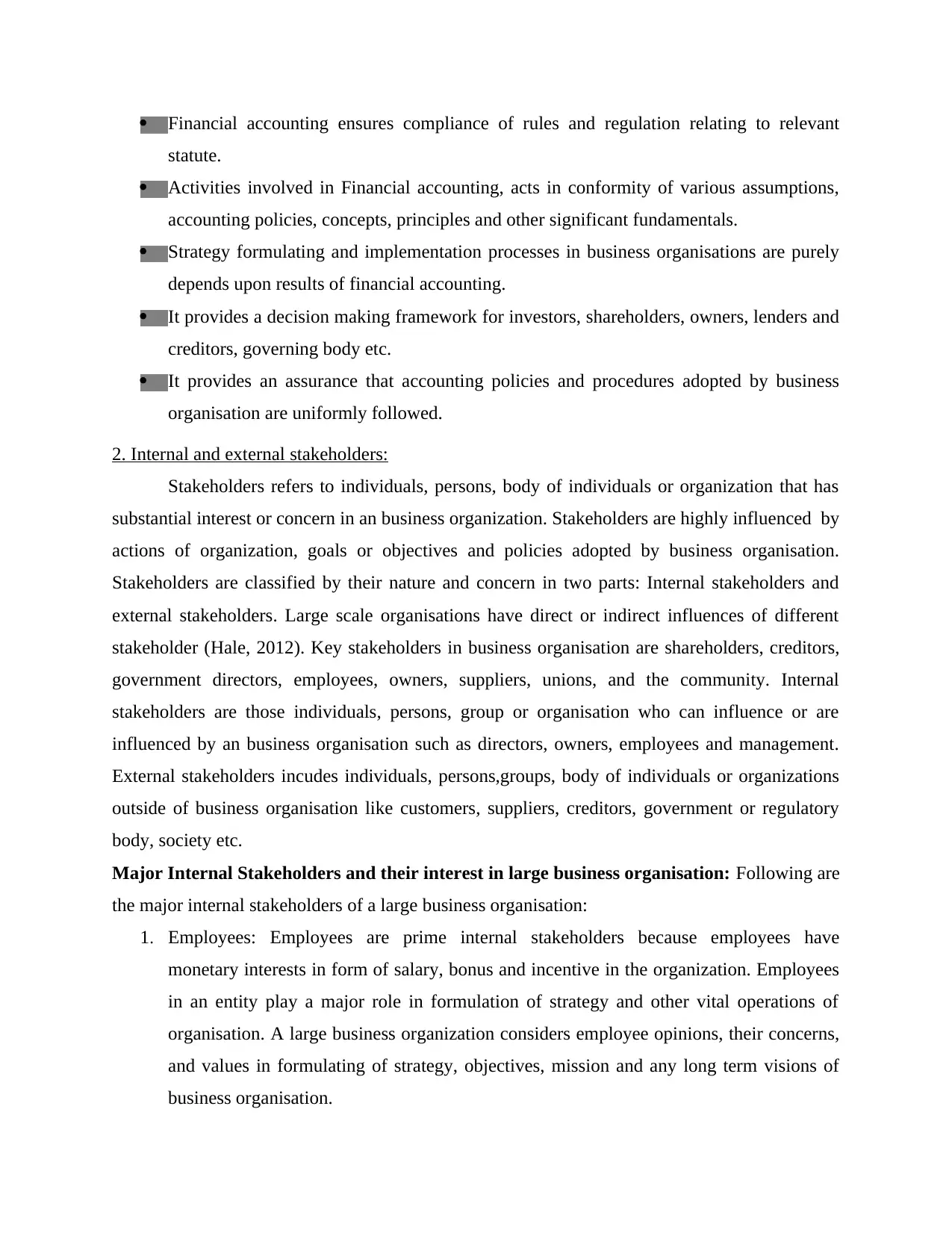
Financial accounting ensures compliance of rules and regulation relating to relevant
statute.
Activities involved in Financial accounting, acts in conformity of various assumptions,
accounting policies, concepts, principles and other significant fundamentals.
Strategy formulating and implementation processes in business organisations are purely
depends upon results of financial accounting.
It provides a decision making framework for investors, shareholders, owners, lenders and
creditors, governing body etc.
It provides an assurance that accounting policies and procedures adopted by business
organisation are uniformly followed.
2. Internal and external stakeholders:
Stakeholders refers to individuals, persons, body of individuals or organization that has
substantial interest or concern in an business organization. Stakeholders are highly influenced by
actions of organization, goals or objectives and policies adopted by business organisation.
Stakeholders are classified by their nature and concern in two parts: Internal stakeholders and
external stakeholders. Large scale organisations have direct or indirect influences of different
stakeholder (Hale, 2012). Key stakeholders in business organisation are shareholders, creditors,
government directors, employees, owners, suppliers, unions, and the community. Internal
stakeholders are those individuals, persons, group or organisation who can influence or are
influenced by an business organisation such as directors, owners, employees and management.
External stakeholders incudes individuals, persons,groups, body of individuals or organizations
outside of business organisation like customers, suppliers, creditors, government or regulatory
body, society etc.
Major Internal Stakeholders and their interest in large business organisation: Following are
the major internal stakeholders of a large business organisation:
1. Employees: Employees are prime internal stakeholders because employees have
monetary interests in form of salary, bonus and incentive in the organization. Employees
in an entity play a major role in formulation of strategy and other vital operations of
organisation. A large business organization considers employee opinions, their concerns,
and values in formulating of strategy, objectives, mission and any long term visions of
business organisation.
statute.
Activities involved in Financial accounting, acts in conformity of various assumptions,
accounting policies, concepts, principles and other significant fundamentals.
Strategy formulating and implementation processes in business organisations are purely
depends upon results of financial accounting.
It provides a decision making framework for investors, shareholders, owners, lenders and
creditors, governing body etc.
It provides an assurance that accounting policies and procedures adopted by business
organisation are uniformly followed.
2. Internal and external stakeholders:
Stakeholders refers to individuals, persons, body of individuals or organization that has
substantial interest or concern in an business organization. Stakeholders are highly influenced by
actions of organization, goals or objectives and policies adopted by business organisation.
Stakeholders are classified by their nature and concern in two parts: Internal stakeholders and
external stakeholders. Large scale organisations have direct or indirect influences of different
stakeholder (Hale, 2012). Key stakeholders in business organisation are shareholders, creditors,
government directors, employees, owners, suppliers, unions, and the community. Internal
stakeholders are those individuals, persons, group or organisation who can influence or are
influenced by an business organisation such as directors, owners, employees and management.
External stakeholders incudes individuals, persons,groups, body of individuals or organizations
outside of business organisation like customers, suppliers, creditors, government or regulatory
body, society etc.
Major Internal Stakeholders and their interest in large business organisation: Following are
the major internal stakeholders of a large business organisation:
1. Employees: Employees are prime internal stakeholders because employees have
monetary interests in form of salary, bonus and incentive in the organization. Employees
in an entity play a major role in formulation of strategy and other vital operations of
organisation. A large business organization considers employee opinions, their concerns,
and values in formulating of strategy, objectives, mission and any long term visions of
business organisation.
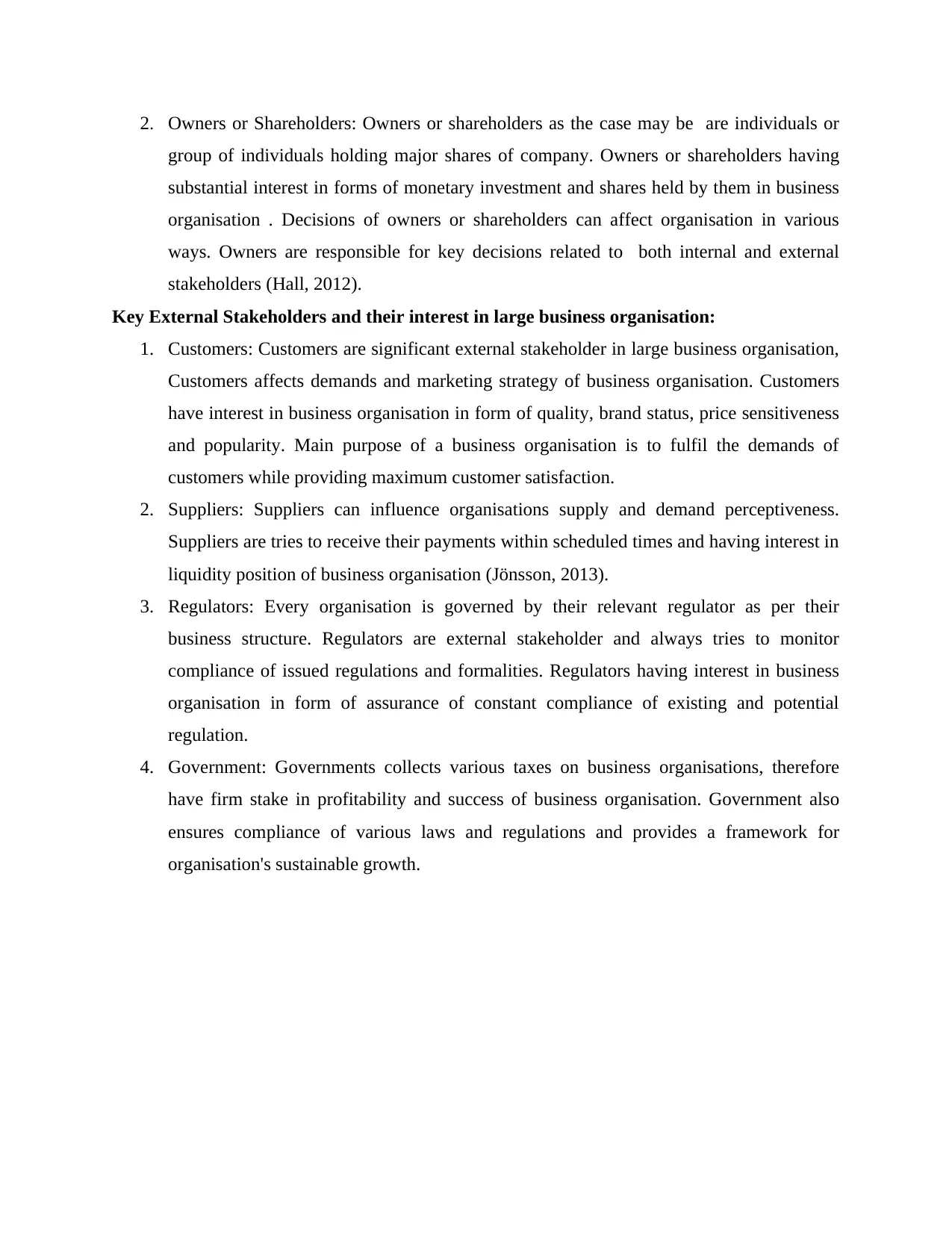
2. Owners or Shareholders: Owners or shareholders as the case may be are individuals or
group of individuals holding major shares of company. Owners or shareholders having
substantial interest in forms of monetary investment and shares held by them in business
organisation . Decisions of owners or shareholders can affect organisation in various
ways. Owners are responsible for key decisions related to both internal and external
stakeholders (Hall, 2012).
Key External Stakeholders and their interest in large business organisation:
1. Customers: Customers are significant external stakeholder in large business organisation,
Customers affects demands and marketing strategy of business organisation. Customers
have interest in business organisation in form of quality, brand status, price sensitiveness
and popularity. Main purpose of a business organisation is to fulfil the demands of
customers while providing maximum customer satisfaction.
2. Suppliers: Suppliers can influence organisations supply and demand perceptiveness.
Suppliers are tries to receive their payments within scheduled times and having interest in
liquidity position of business organisation (Jönsson, 2013).
3. Regulators: Every organisation is governed by their relevant regulator as per their
business structure. Regulators are external stakeholder and always tries to monitor
compliance of issued regulations and formalities. Regulators having interest in business
organisation in form of assurance of constant compliance of existing and potential
regulation.
4. Government: Governments collects various taxes on business organisations, therefore
have firm stake in profitability and success of business organisation. Government also
ensures compliance of various laws and regulations and provides a framework for
organisation's sustainable growth.
group of individuals holding major shares of company. Owners or shareholders having
substantial interest in forms of monetary investment and shares held by them in business
organisation . Decisions of owners or shareholders can affect organisation in various
ways. Owners are responsible for key decisions related to both internal and external
stakeholders (Hall, 2012).
Key External Stakeholders and their interest in large business organisation:
1. Customers: Customers are significant external stakeholder in large business organisation,
Customers affects demands and marketing strategy of business organisation. Customers
have interest in business organisation in form of quality, brand status, price sensitiveness
and popularity. Main purpose of a business organisation is to fulfil the demands of
customers while providing maximum customer satisfaction.
2. Suppliers: Suppliers can influence organisations supply and demand perceptiveness.
Suppliers are tries to receive their payments within scheduled times and having interest in
liquidity position of business organisation (Jönsson, 2013).
3. Regulators: Every organisation is governed by their relevant regulator as per their
business structure. Regulators are external stakeholder and always tries to monitor
compliance of issued regulations and formalities. Regulators having interest in business
organisation in form of assurance of constant compliance of existing and potential
regulation.
4. Government: Governments collects various taxes on business organisations, therefore
have firm stake in profitability and success of business organisation. Government also
ensures compliance of various laws and regulations and provides a framework for
organisation's sustainable growth.
⊘ This is a preview!⊘
Do you want full access?
Subscribe today to unlock all pages.

Trusted by 1+ million students worldwide
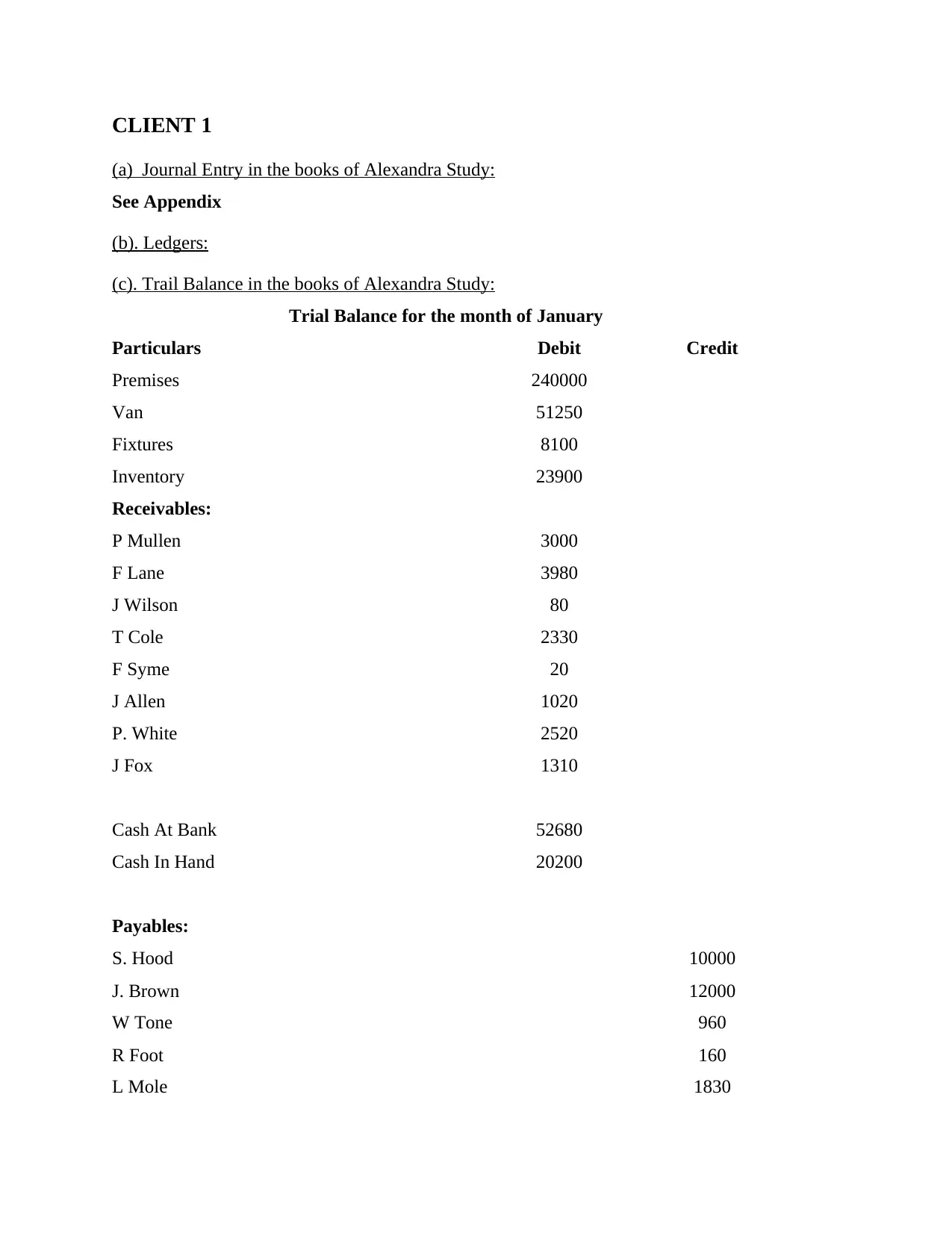
CLIENT 1
(a) Journal Entry in the books of Alexandra Study:
See Appendix
(b). Ledgers:
(c). Trail Balance in the books of Alexandra Study:
Trial Balance for the month of January
Particulars Debit Credit
Premises 240000
Van 51250
Fixtures 8100
Inventory 23900
Receivables:
P Mullen 3000
F Lane 3980
J Wilson 80
T Cole 2330
F Syme 20
J Allen 1020
P. White 2520
J Fox 1310
Cash At Bank 52680
Cash In Hand 20200
Payables:
S. Hood 10000
J. Brown 12000
W Tone 960
R Foot 160
L Mole 1830
(a) Journal Entry in the books of Alexandra Study:
See Appendix
(b). Ledgers:
(c). Trail Balance in the books of Alexandra Study:
Trial Balance for the month of January
Particulars Debit Credit
Premises 240000
Van 51250
Fixtures 8100
Inventory 23900
Receivables:
P Mullen 3000
F Lane 3980
J Wilson 80
T Cole 2330
F Syme 20
J Allen 1020
P. White 2520
J Fox 1310
Cash At Bank 52680
Cash In Hand 20200
Payables:
S. Hood 10000
J. Brown 12000
W Tone 960
R Foot 160
L Mole 1830
Paraphrase This Document
Need a fresh take? Get an instant paraphrase of this document with our AI Paraphraser
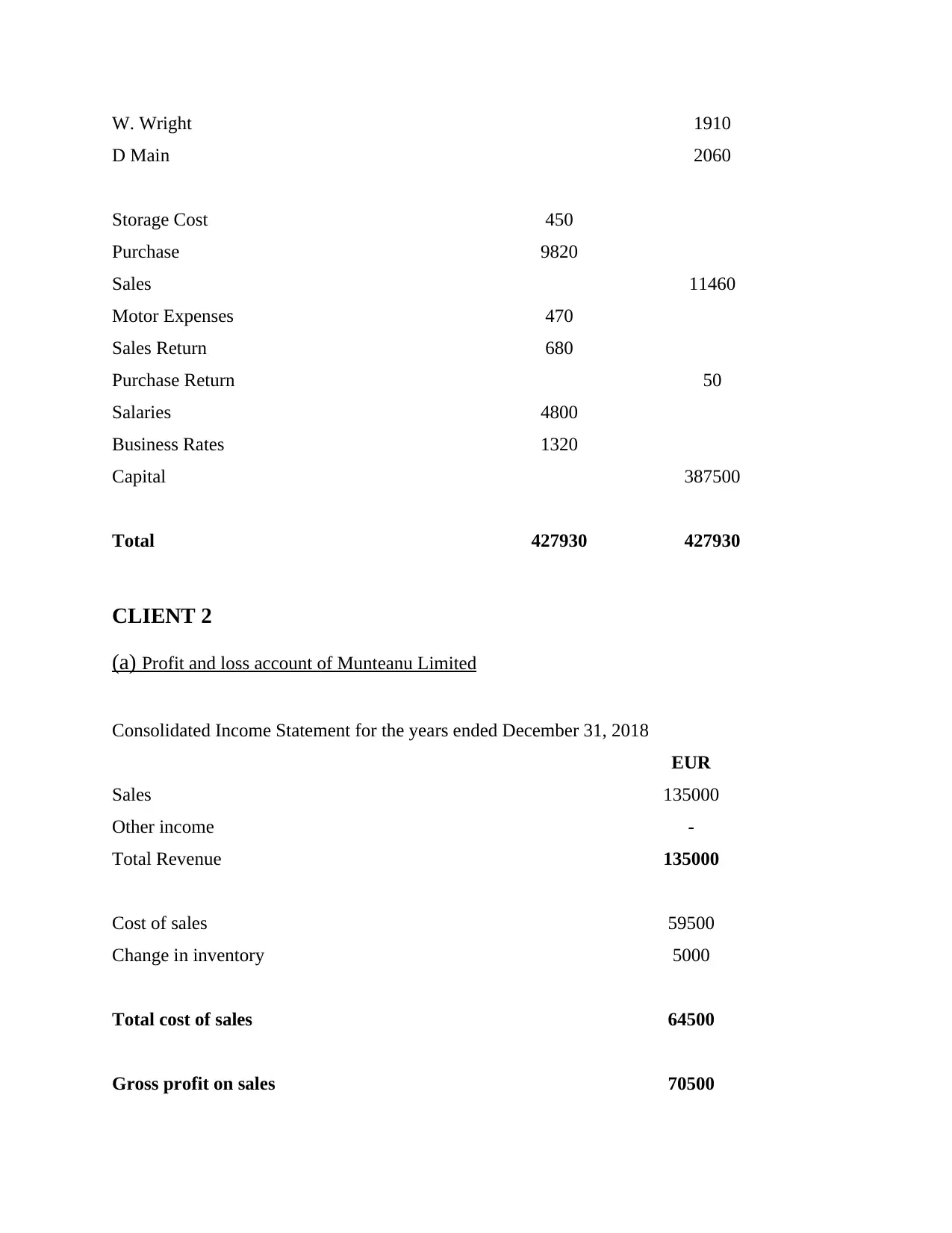
W. Wright 1910
D Main 2060
Storage Cost 450
Purchase 9820
Sales 11460
Motor Expenses 470
Sales Return 680
Purchase Return 50
Salaries 4800
Business Rates 1320
Capital 387500
Total 427930 427930
CLIENT 2
(a) Profit and loss account of Munteanu Limited
Consolidated Income Statement for the years ended December 31, 2018
EUR
Sales 135000
Other income -
Total Revenue 135000
Cost of sales 59500
Change in inventory 5000
Total cost of sales 64500
Gross profit on sales 70500
D Main 2060
Storage Cost 450
Purchase 9820
Sales 11460
Motor Expenses 470
Sales Return 680
Purchase Return 50
Salaries 4800
Business Rates 1320
Capital 387500
Total 427930 427930
CLIENT 2
(a) Profit and loss account of Munteanu Limited
Consolidated Income Statement for the years ended December 31, 2018
EUR
Sales 135000
Other income -
Total Revenue 135000
Cost of sales 59500
Change in inventory 5000
Total cost of sales 64500
Gross profit on sales 70500

Distribution cost 32000
Administrative costs 32000
Depreciation 3400
Finance cost 1500
Income before income taxes 1600
-
Income before income taxes 1600
(b) Balance Sheet of Munteanu Limited
Consolidated Balance Sheets for the years ended December 31, 2018
Assets Amount in EUR
Land 20000
Building 40000
Less: Accumulated Depreciation 10000
30000
Depreciation for the year 600 29400
Plant and machinery 60000
Less: Depreciation 20000
40000
Depreciation for the year 8000 32000
Total non-current assets 81400
Inventories 20000
Prepaid Rent 3000
Accounts receivable 26000
Total current assets 49000
Total assets 130400
Equity and liabilities
Administrative costs 32000
Depreciation 3400
Finance cost 1500
Income before income taxes 1600
-
Income before income taxes 1600
(b) Balance Sheet of Munteanu Limited
Consolidated Balance Sheets for the years ended December 31, 2018
Assets Amount in EUR
Land 20000
Building 40000
Less: Accumulated Depreciation 10000
30000
Depreciation for the year 600 29400
Plant and machinery 60000
Less: Depreciation 20000
40000
Depreciation for the year 8000 32000
Total non-current assets 81400
Inventories 20000
Prepaid Rent 3000
Accounts receivable 26000
Total current assets 49000
Total assets 130400
Equity and liabilities
⊘ This is a preview!⊘
Do you want full access?
Subscribe today to unlock all pages.

Trusted by 1+ million students worldwide
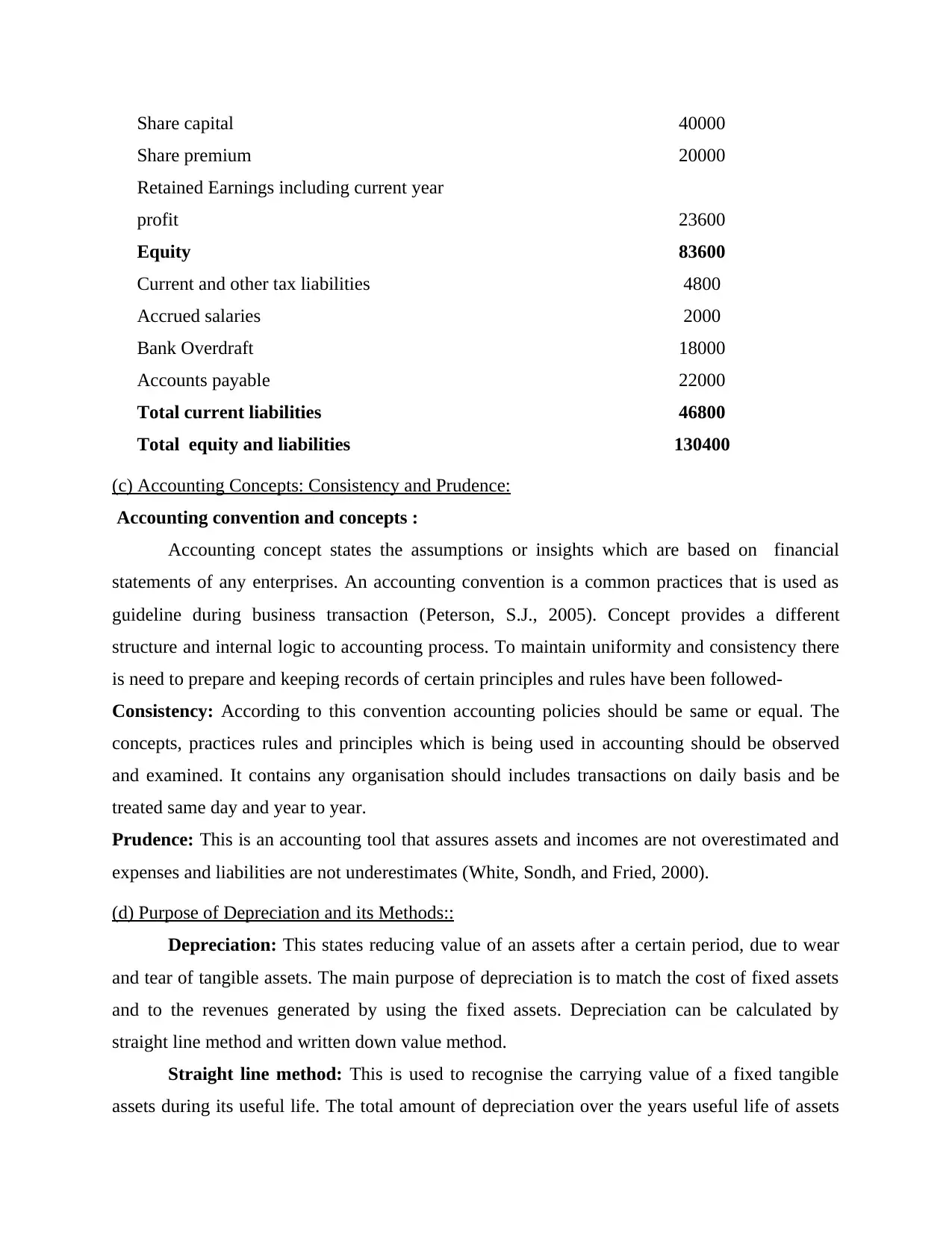
Share capital 40000
Share premium 20000
Retained Earnings including current year
profit 23600
Equity 83600
Current and other tax liabilities 4800
Accrued salaries 2000
Bank Overdraft 18000
Accounts payable 22000
Total current liabilities 46800
Total equity and liabilities 130400
(c) Accounting Concepts: Consistency and Prudence:
Accounting convention and concepts :
Accounting concept states the assumptions or insights which are based on financial
statements of any enterprises. An accounting convention is a common practices that is used as
guideline during business transaction (Peterson, S.J., 2005). Concept provides a different
structure and internal logic to accounting process. To maintain uniformity and consistency there
is need to prepare and keeping records of certain principles and rules have been followed-
Consistency: According to this convention accounting policies should be same or equal. The
concepts, practices rules and principles which is being used in accounting should be observed
and examined. It contains any organisation should includes transactions on daily basis and be
treated same day and year to year.
Prudence: This is an accounting tool that assures assets and incomes are not overestimated and
expenses and liabilities are not underestimates (White, Sondh, and Fried, 2000).
(d) Purpose of Depreciation and its Methods::
Depreciation: This states reducing value of an assets after a certain period, due to wear
and tear of tangible assets. The main purpose of depreciation is to match the cost of fixed assets
and to the revenues generated by using the fixed assets. Depreciation can be calculated by
straight line method and written down value method.
Straight line method: This is used to recognise the carrying value of a fixed tangible
assets during its useful life. The total amount of depreciation over the years useful life of assets
Share premium 20000
Retained Earnings including current year
profit 23600
Equity 83600
Current and other tax liabilities 4800
Accrued salaries 2000
Bank Overdraft 18000
Accounts payable 22000
Total current liabilities 46800
Total equity and liabilities 130400
(c) Accounting Concepts: Consistency and Prudence:
Accounting convention and concepts :
Accounting concept states the assumptions or insights which are based on financial
statements of any enterprises. An accounting convention is a common practices that is used as
guideline during business transaction (Peterson, S.J., 2005). Concept provides a different
structure and internal logic to accounting process. To maintain uniformity and consistency there
is need to prepare and keeping records of certain principles and rules have been followed-
Consistency: According to this convention accounting policies should be same or equal. The
concepts, practices rules and principles which is being used in accounting should be observed
and examined. It contains any organisation should includes transactions on daily basis and be
treated same day and year to year.
Prudence: This is an accounting tool that assures assets and incomes are not overestimated and
expenses and liabilities are not underestimates (White, Sondh, and Fried, 2000).
(d) Purpose of Depreciation and its Methods::
Depreciation: This states reducing value of an assets after a certain period, due to wear
and tear of tangible assets. The main purpose of depreciation is to match the cost of fixed assets
and to the revenues generated by using the fixed assets. Depreciation can be calculated by
straight line method and written down value method.
Straight line method: This is used to recognise the carrying value of a fixed tangible
assets during its useful life. The total amount of depreciation over the years useful life of assets
Paraphrase This Document
Need a fresh take? Get an instant paraphrase of this document with our AI Paraphraser

would be less out of the full amount of assets any assumed salvage value (Khan and Mayes,
2009).
Written down value method: This is an accounting reducing method that reduces the
value of an assets by a fixed percentage every year. Its values are reduced year to year and helps
to define the minimum value foe which it would be sold.
(e) Evaluation of difference between financial statements prepared by sole traders and limited
companies :
Financial statements are the final reports of any organisation that includes financial
activities and position of a business, entity or other person. It also contains a balance sheet or
statement records of a company's assets, owner's equity and liabilities at a given time.
For sole trader: financial statements are maintained by the sole proprietor or trader at small size
of company. It includes financial position of a sole trader that is shown by the holding amount of
assets and the amount of owner's capital. In this type of business audit is not compulsory.
For limited company: These are prepared by the wider size of company which is controlled by
the government or other stakeholders. There is internal and external audit is needed by the
organisation that helps to provide tax benefits (Saunders, Cornett and McGraw, 2006).
CLIENT 3
1. Purpose of preparation of Bank Reconciliation Statement:
Bank reconciliation statement is prepared by business organisation to reconcile the
balance of bank account as prepared in cash book with amount shown in bank statements. Bank-
reconciliation statements may be prepared on monthly, quarterly or annually however
organisation should prepare bank-reconciliation statements on monthly basis in order to avoid
any complexity or inconsistency in accounts (Libby, Bloomfield and Nelson, 2002).
2 . Areas where bank records vary from personal records
Difference between bank balance as per cash book and bank balance in bank statements
arises due to bank charges charged by banks, direct deposit of any amount by any party, cheque
issued but not presented and due to other charges charged by bank without ant further
information.
2009).
Written down value method: This is an accounting reducing method that reduces the
value of an assets by a fixed percentage every year. Its values are reduced year to year and helps
to define the minimum value foe which it would be sold.
(e) Evaluation of difference between financial statements prepared by sole traders and limited
companies :
Financial statements are the final reports of any organisation that includes financial
activities and position of a business, entity or other person. It also contains a balance sheet or
statement records of a company's assets, owner's equity and liabilities at a given time.
For sole trader: financial statements are maintained by the sole proprietor or trader at small size
of company. It includes financial position of a sole trader that is shown by the holding amount of
assets and the amount of owner's capital. In this type of business audit is not compulsory.
For limited company: These are prepared by the wider size of company which is controlled by
the government or other stakeholders. There is internal and external audit is needed by the
organisation that helps to provide tax benefits (Saunders, Cornett and McGraw, 2006).
CLIENT 3
1. Purpose of preparation of Bank Reconciliation Statement:
Bank reconciliation statement is prepared by business organisation to reconcile the
balance of bank account as prepared in cash book with amount shown in bank statements. Bank-
reconciliation statements may be prepared on monthly, quarterly or annually however
organisation should prepare bank-reconciliation statements on monthly basis in order to avoid
any complexity or inconsistency in accounts (Libby, Bloomfield and Nelson, 2002).
2 . Areas where bank records vary from personal records
Difference between bank balance as per cash book and bank balance in bank statements
arises due to bank charges charged by banks, direct deposit of any amount by any party, cheque
issued but not presented and due to other charges charged by bank without ant further
information.
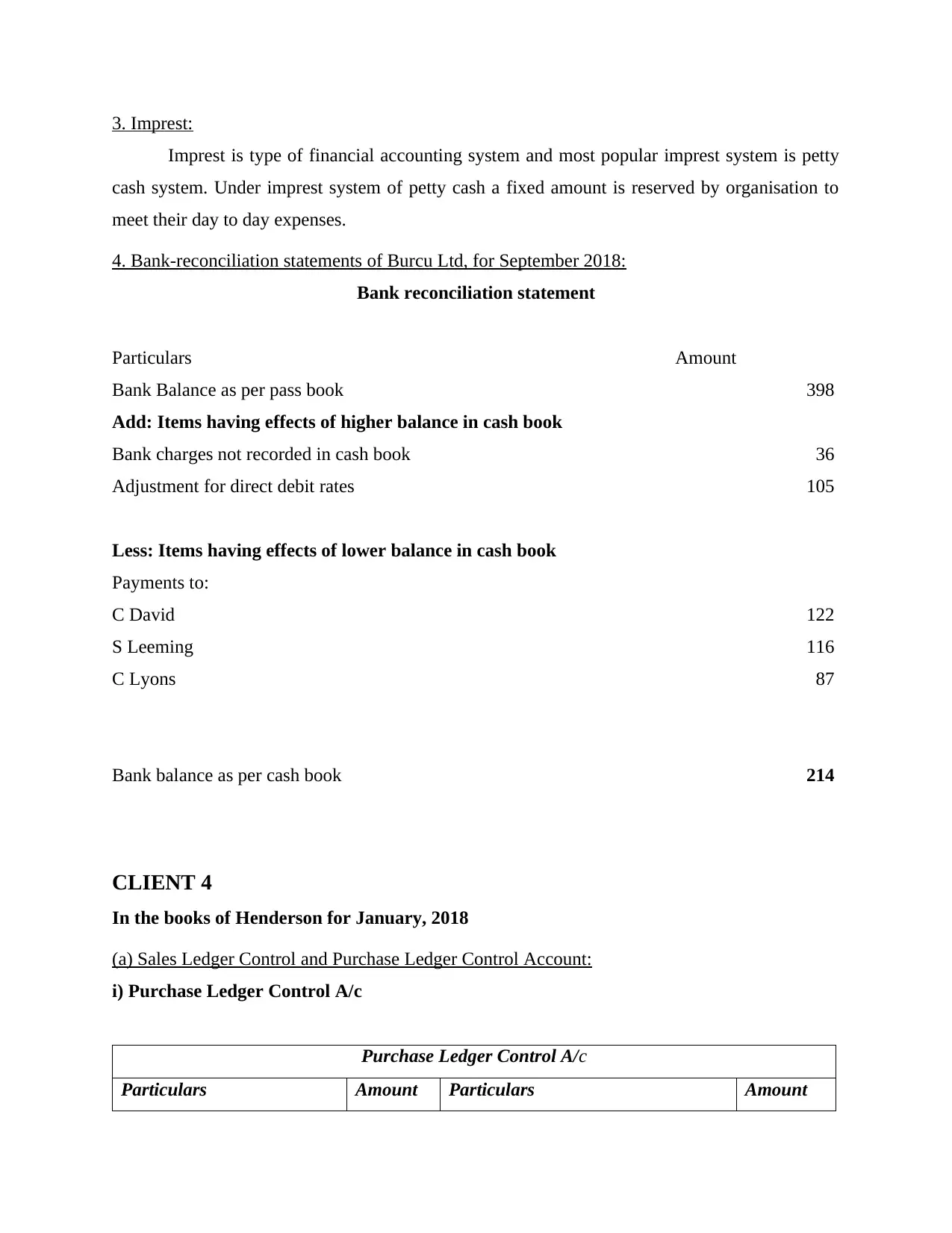
3. Imprest:
Imprest is type of financial accounting system and most popular imprest system is petty
cash system. Under imprest system of petty cash a fixed amount is reserved by organisation to
meet their day to day expenses.
4. Bank-reconciliation statements of Burcu Ltd, for September 2018:
Bank reconciliation statement
Particulars Amount
Bank Balance as per pass book 398
Add: Items having effects of higher balance in cash book
Bank charges not recorded in cash book 36
Adjustment for direct debit rates 105
Less: Items having effects of lower balance in cash book
Payments to:
C David 122
S Leeming 116
C Lyons 87
Bank balance as per cash book 214
CLIENT 4
In the books of Henderson for January, 2018
(a) Sales Ledger Control and Purchase Ledger Control Account:
i) Purchase Ledger Control A/c
Purchase Ledger Control A/c
Particulars Amount Particulars Amount
Imprest is type of financial accounting system and most popular imprest system is petty
cash system. Under imprest system of petty cash a fixed amount is reserved by organisation to
meet their day to day expenses.
4. Bank-reconciliation statements of Burcu Ltd, for September 2018:
Bank reconciliation statement
Particulars Amount
Bank Balance as per pass book 398
Add: Items having effects of higher balance in cash book
Bank charges not recorded in cash book 36
Adjustment for direct debit rates 105
Less: Items having effects of lower balance in cash book
Payments to:
C David 122
S Leeming 116
C Lyons 87
Bank balance as per cash book 214
CLIENT 4
In the books of Henderson for January, 2018
(a) Sales Ledger Control and Purchase Ledger Control Account:
i) Purchase Ledger Control A/c
Purchase Ledger Control A/c
Particulars Amount Particulars Amount
⊘ This is a preview!⊘
Do you want full access?
Subscribe today to unlock all pages.

Trusted by 1+ million students worldwide
1 out of 24
Related Documents
Your All-in-One AI-Powered Toolkit for Academic Success.
+13062052269
info@desklib.com
Available 24*7 on WhatsApp / Email
![[object Object]](/_next/static/media/star-bottom.7253800d.svg)
Unlock your academic potential
Copyright © 2020–2025 A2Z Services. All Rights Reserved. Developed and managed by ZUCOL.





